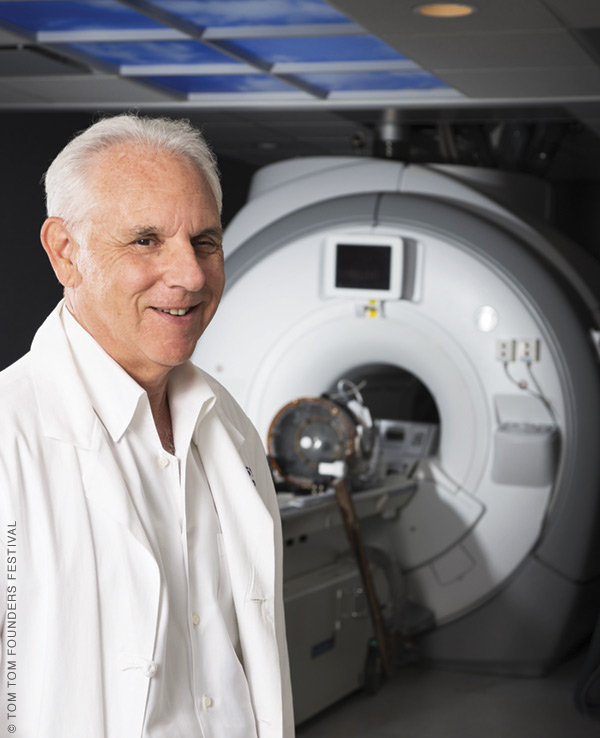
This neurosurgeon’s foundation has propelled a groundbreaking medical technology.
Neurosurgeon Neal Kassell C’68 M’72 GM’79 still remembers the moment he first stumbled upon the idea thatwould change his life. “It was about 18 years ago, at 4:30 in the afternoon,” he says. “I had been casting around for a solution to help a fairly large number of my patients who had surgically inaccessible brain tumors or who had maxed out on surgery and radiation and chemo. And there I was, driving home from the hospital, and a lightbulb just went off in my head.”
He wondered: Why not use focused ultrasound? FUS was a new technology he had only recently begun using to measure blood flow. But could it also be harnessed to destroy tumors?
“I was certain it could be a Nobel Prize-winning idea,” he laughs. “I raced home and went to the internet … and saw that someone else had already thought of it.” But the notion had gotten hold of him. And now, two decades later, he serves as the chairman of the Focused Ultrasound Foundation, a nonprofit he founded in 2006 to encourage the development and commercialization of FUS.
A non-invasive treatment that can destroy tumors and deliver medication via precision application of high-frequency sound (thus minimizing the side effects of nausea and hair loss that come with radiation and chemotherapy), FUS is now used to treat a wide range of conditions. These include uterine fibroids (accounting for about 30 percent of FUS treatments in 2020), pancreatic and liver tumors, prostate disease, glaucoma, and brain disorders like essential tremors and Parkinson’s. The foundation estimates that FUS has the potential to help more than one million patients with some 150 medical conditions every year.
Studies have also shown that FUS can be used to enhance cancer immunotherapy by “stripping away the camouflage” that hides tumors in some patients, which Kassell calls an “important breakthrough” that the foundation is “putting a lot of time, energy, and money” toward.
Technology has always enticed Kassell. He began with ham radio as a kid, and by the time he was a medical student, he was dreaming up inventions like an early version of an electronic medical record system. He knew he wanted to be a neurologist since fourth grade, but school was never easy for him.
In high school, Kassell flunked calculus but wound up working in a research lab thanks to a former camp counselor who was attending medical school at Penn. “I even got into the operating room,” he says, “which would never happen these days.” When he entered Penn himself, his continued work at the lab conspired with his short attention span to produce a poor GPA that prevented him from graduating. Still, thanks in part to papers he had published and recommendation letters he received, he says he managed to gain admission to medical school at Penn … and this time did graduate.
Nearly 40 years of academia followed—first at the University of Iowa and then the University of Virginia, where he served as cochair of the neurology department. But in 2016, he left it all behind to fully focus on the foundation he had established 10 years earlier.
Since its founding, the nonprofit has raised $170 million. Kassell credits an early clinical trial on FUS and essential tremors, which the foundation designed and funded, with getting the ball rolling. “It helped secure the first FDA approval [in 2016] and to open treatment centers,” he says. “This was really important because even though tremors are not a huge epidemiological problem like lung cancer, they involve the brain and everyone is interested in the brain. There was also the sense that if you could treat something with a high degree of precision and accuracy in the middle of the brain then the same technology could be used in [other] locations.”
FUS is now approved for seven uses in the US and 30 worldwide, and last year about 80,000 patients received it at 800 sites around the globe. Penn Medicine has used the therapy to treat more than 100 patients with essential tremors and Parkinson’s disease—the way Kassell originally envisioned—since 2017. Currently, treatment of these two conditions, as well as bone metastases and prostate cancer, are eligible for insurance reimbursement in the US.
Kassell likens the technology to the state of magnetic resonance imaging (MRI) three decades ago. MRIs ultimately revolutionized diagnostics, as success stories spurred increased awareness from doctors, patients, and manufacturers. Kassell hopes the same dynamic will drive more regulatory and reimbursement approvals for FUS. “This is not a silver bullet. It’s not a panacea that’s right for every patient and every disorder,” he says. “It can’t work for something like leukemia, say, because there’s nothing to target.
“There’s a lot of work to figure out where FUS will provide unique value.”
Kassell still feels the lure of the brain—he often dreams about returning to the thrill and challenge of performing brain surgery—but he knows his most important work lies ahead. “My practice helped several hundred patients a year,” he says. “The research I was doing impacted thousands a year. FUS will impact millions a year. This work turned out to be a lot harder and more complicated than I ever imagined—with all the stakeholders, it’s often like trying to feed 30 barking dogs at the same time. But there was a moral imperative for me.”
—JoAnn Greco




